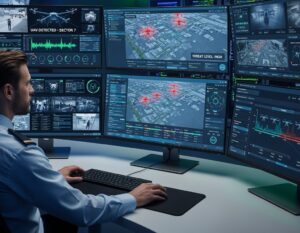

Modern security environments demand more than just advanced technology. They require that the right systems can be used quickly and confidently, even while users are under pressure. As the threat of unauthorized drones grows more frequent and dangerous across military, law enforcement, and homeland security settings, the success of any counter-UAV operation often hinges on a critical variable: the human factor.
From user interface design to real-world training, cognitive load and decision speed are critical, making human-centered design just as essential as the technology itself. In this blog, we explore why the operator experience matters, how it impacts mission outcomes, and what it means for the future of counter-UAV success.

While technological advancements have transformed counter-UAV capabilities, enabling precise detection, identification, and control of unauthorized drones, the effectiveness of these systems quite often ultimately relies on the people operating them.
In high-stress environments such as crowded stadiums, border patrol zones, or active conflict areas, every second matters. Poorly designed user interfaces, complicated control systems, and a lack of intuitive response options can slow down critical decision-making. When facing a rogue drone, even minor delays can lead to major consequences.
That is why human factors, specifically interface clarity, user training, and operational usability, are not secondary considerations. They are mission-critical.
In the heat of a real-world drone incident, clarity is a requirement. An intuitive, clean, and minimal interface can help operators act with confidence rather than confusion. Clever design minimizes information overload, highlights priority threats, and offers clear, decisive action paths.
Counter-drone systems like EnforceAir have demonstrated how intuitive dashboards and automated workflows can shorten decision cycles and reduce the chance of human error. By offering visual simplicity without sacrificing functionality, these interfaces allow operators, military or civilian, to focus on what matters most: responding fast and effectively.
The difference between scanning a cluttered screen versus receiving a real-time visual alert with a recommended mitigation action can be the difference between operational success and failure.
Effective training goes beyond system walkthroughs or instruction manuals. It includes simulation-based learning and scenario drills that mimic the real-time pace and unpredictability of drone incidents. Operators need to build not just technical proficiency, but also confidence and muscle memory to make rapid decisions under pressure.
Field-tested systems also reduce the training burden. When tools are intuitive, the learning curve shortens. When workflows mirror real-world thinking, responses become natural. The goal is to build competence that endures when adrenaline spikes.
Proper initial training is crucial, but it doesn’t end there. As the system evolves and is enriched with new features, it’s critical for operators to have ongoing access to up-to-date training materials, comprehensive documentation, and the latest software releases. Online, remote, and onsite training, such as that provided by The D-Fend Academy, supports this continuous learning by providing structured training sessions, updated content, and hands-on practical exercises to ensure operators remain effective and confident in the field.
In counter-UAV missions, time is a finite and fragile resource. Legacy systems that require layered approval chains, complex mechanical setups, or manual targeting routines can create dangerous delays.
Modern systems must prioritize speed without sacrificing control or safety. That means providing automatic drone detection with smart alerts, built-in threat classification, and one-click mitigation options. These features allow operators to quickly assess a drone’s intent and apply the right response, from monitoring to safe takeover, within seconds.
Response time is especially critical when protecting dynamic or civilian environments. In stadiums, transportation hubs, or urban centers, rapid resolution can prevent panic, disruption, or worse. Human-centered systems make that possible.
Stress impairs judgment. That is a fact supported by decades of operational psychology. During high-pressure events, humans are more prone to tunnel vision, reduced working memory, and slower processing. In counter-UAV missions, where split-second choices are required, minimizing cognitive load becomes essential.
This is where system simplicity and automation come into play. Reducing the number of decisions an operator must make, while clearly displaying only the most relevant data, can dramatically improve performance. By guiding users through mitigation steps with built-in protocols and visual cues, well-designed systems support good judgment, even in moments of chaos.
The importance of human factors in counter-UAV operations is not limited to defense forces. Homeland security teams, airport authorities, law enforcement, and critical infrastructure operators all rely on trained personnel in the field. Each of these sectors faces varying threat types, environments, and operational constraints, but they all share a common need: systems that empower people to act fast, clearly, and safely.
From border crossings to correctional facilities, the success of counter-UAV efforts depends on how well humans and machines work together. Technology provides the tools, but trained, supported operators deliver the results.
As drone threats evolve, so must the solutions designed to contend with them. Precision counter-UAV technology, like EnforceAir PLUS, must go hand in hand with operator readiness. That means intuitive interfaces, rapid deployment, and robust training environments.
At D-Fend Solutions, our commitment to supporting operational success extends beyond product development. We work closely with security partners to provide field-validated systems that not only meet technological needs but also reflect real-world operator workflows. In modern airspace security, human factors are not just “nice to haves,” but, rather, critical for mission success.
Because even the most advanced systems rely on people. Interface clarity, training, and response speed directly impact mission success and safety.
An intuitive, streamlined interface reduces confusion, minimizes human error, and enables operators to respond faster to rogue drone incidents.
Hands-on, scenario-based training builds confidence and muscle memory, preparing operators to make rapid, accurate decisions under stress. Beyond initial training, ongoing support from solution providers, such as that given by the D-Fend Academy, ensures operators have access to up-to-date training materials, documentation, and software releases, helping them stay proficient as technology evolves and new features are introduced.
Every second matters. Systems that provide real-time detection, smart alerts, and fast mitigation options allow operators to neutralize threats quickly.